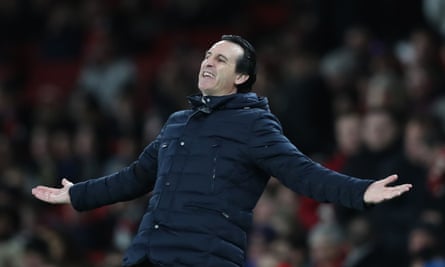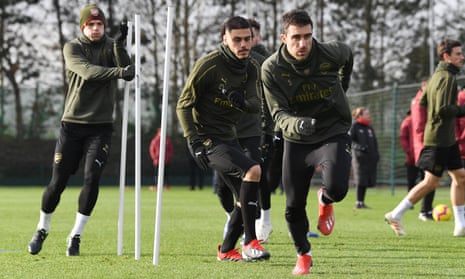It was the news that Arsenal supporters had longed to hear and it was delivered with an uncharacteristic flourish by Ivan Gazidis. The date was 6 June 2013 and the club’s then chief executive told a group of journalists that Arsenal’s austerity era – necessitated by the move to Emirates Stadium in 2006 – was over.
The long-term commercial deals that Arsenal had felt compelled to lock into so they could secure money up front for the stadium were expiring and the result, according to Gazidis, was an “escalation” in the club’s “financial firepower”. Anything was possible on the transfer market, he suggested, including the signing of A-list players. “We are moving into a new phase where, if we make our decisions well, we can compete with any club in the world,” Gazidis said.
At the end of that summer, Arsenal would sign Mesut Özil and there have since been a smattering of other statement purchases – namely Alexis Sánchez, Alexandre Lacazette and Pierre-Emerick Aubameyang. But as the club prepare for Saturday’s pivotal Premier League game at home to Chelsea, the mood is edgy and not only because defeat could leave them nine points adrift of the Champions League places by the end of the weekend.
This month Arsenal cannot compete with any club for any permanent signing because, quite simply, the money is not there. It will be a loan or two, at best – perhaps, with a built-in option to buy in the summer, when the new sponsorship arrangements with Emirates and Adidas kick in – and there is bewilderment, to say the least, among some fans.
The club’s most recently published accounts, for the six months ended November 2017, showed a profit before tax of £25.1m and cash reserves of £160.7m – including debt service reserves of £23m, which are not available for football purposes. This time last year Arsenal were listed at No 6 on Deloitte’s world football money league. What is going on?
The sense of unease has been swelled by the looming loss of Aaron Ramsey to Juventus as a free agent at the end of the season for reasons that are impossible to disconnect from finance. Then, there is Sven Mislintat, the head of recruitment, who arrived from Borussia Dortmund in November 2017. He has grown so frustrated that he has decided to quit; he is expected to leave after the closure of the January window.
Mislintat was one of the three decision-makers who appointed Unai Emery as the managerial successor to Arsène Wenger last May. Gazidis was another but he walked out last October to join Milan, which means that Raúl Sanllehí, the director of football, is set to be the last man standing. The impression is one of behind-the-scenes turmoil.
Arsenal’s financial freeze can be explained by a number of factors. According to the club, the cash reserves in the bank are not merely savings, they are to help with the annual running costs. Large sums of money routinely move in and out of the accounts – such as the instalments on transfer fees or commercial deals – and they might do so after the cut-off for a specific financial period.

The analogy is to a family’s monthly budget. In some months, it is necessary to dip into the overdraft. It is not as simple as looking at Arsenal’s year-to-year numbers. As for the half-yearly profits, they were heavily influenced by player sales in the summer of 2017 and that of a development site near the Emirates Stadium on Holloway Road.
A more convincing point takes in the fundamental reality under Stan Kroenke, who has been the majority shareholder since April 2011 – the club are wedded to a self-financing business model. What comes out must first have been generated from within.
The statistics show that since the summer of 2011, Arsenal have a net spend on permanent transfer fees of £239.9m, which works out at £30m per season. Since the summer of 2013, when Gazidis talked the talk and the shackles came off, it has been £265.8m or £44.3m per season. In other words, not enough to buy a Kyle Walker and significantly short of a Virgil van Dijk.
A club’s net spend is not the perfect barometer of its financial health; player wages are also a massive part of it and Arsenal’s investment in this area has soared from year to year. But it is nevertheless a decent one. There have been seasons under Kroenke in which Arsenal have pushed the boat out by this measure, namely 2014-15, 2016-17 and the current one. They have invariably been followed by a levelling-off.
This season illustrates the point in microcosm. Last summer the club spent £71.4m on five players, including Bernd Leno, Sokratis Papastathopoulos and Lucas Torreira, and recouped only £7.6m in sales. It added up to a net spend that was significantly above the mean but it meant the cupboard was always going to be bare come January. Emery knew it would be the case. When he accepted the job, he knew what he was signing up for.
Arsenal’s headache is that they have a squad on Champions League wages in year two of a Europa League cycle. The push last summer was an attempt to catapult them back to the elite level and it has increased the jeopardy. The Champions League resembles an express train and when teams fall off it they have to work even harder to reboard – and that can equate to spending.
When Manchester United slipped out of the Champions League for 2016-17, they spent over the odds to persuade Paul Pogba, Zlatan Ibrahimovic, Eric Bailly and Henrikh Mkhitaryan to join up for a Europa League campaign with the promise of clawing back to the top level. In the end, they won the Europa League to regain their Champions League status. Each year a club is out of the competition, it becomes harder to get back in. Liverpool could attest to that.
Arsenal’s self-sustaining model has been squeezed by Europa League revenues and the circle can, in time, become vicious. “The reduction in distributions from Uefa for Arsenal last season when they reached the Europa League semi-final, which reflect broadcast revenues, was €26.8m – compared to the amount they received from being in the Champions League the season before,” said Tim Bridge, a director in Deloitte’s sports business group. “But any club in the Europa League will also likely see an impact on match-day and commercial revenues compared with those in the Champions League.”
Have Arsenal made their decisions well, as Gazidis hoped they would? The one to give Özil a new £350,000-a-week contract last February to run until 2021 (total value: £62.2m) was based on how it might cost them more to sign a replacement and the nightmare prospect of him leaving on a Bosman, so soon after Sánchez had forced his way to United.
One of the consequences has been the withdrawal of the contract offer to Ramsey but Emery has come to doubt Özil’s worth. The manager has integrated the summer signings and those on Mislintat’s watch – chief among them Aubameyang – have generally been positive. But further surgery is required and while money is not everything – witness the work of Mauricio Pochettino at Tottenham – it is certainly something.
Emery has brought stirring home performances, tactical variety and genuine excitement, at times. The scale of his challenge, and how delicately it is poised, remains clear.

Comments (…)
Sign in or create your Guardian account to join the discussion